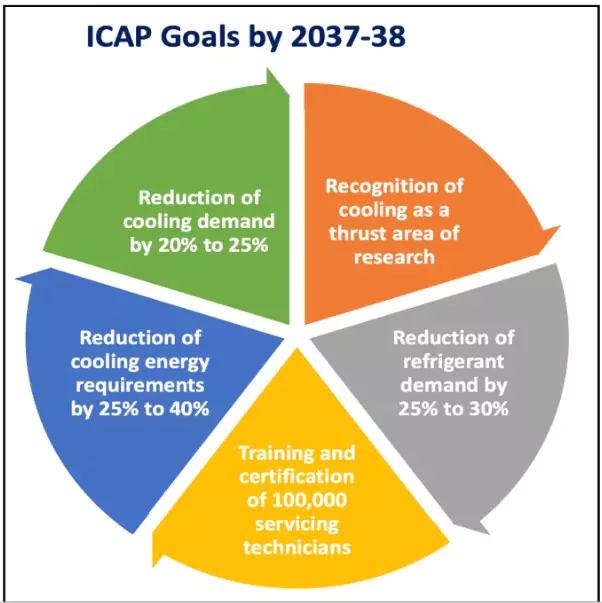Recently, Minister of Environment, Forest and Climate Change (MoEFCC), said that India has become one of the first countries in the world to have a cooling action plan.
- India marked World Ozone Day 2025 (16th September) under the theme “From Science to Global Action”
India’s Engagement with Global Ozone Protection
- Vienna Convention (1985): First international framework for ozone protection.
- Montreal Protocol (1987): Landmark treaty to phase out Ozone Depleting Substances (ODS) like CFCs and halons.
- India as a Party: Signed in 1992; committed to phasing out harmful chemicals.
- ODS Regulation and Control Rules (2000): Enacted to implement the Montreal Protocol by regulating the production, consumption, import, and export of Ozone Depleting Substances (ODS).
- These rules established quotas for ODS production based on a 2000 baseline, prohibited trade with non-specified countries, required licenses for import/export with specified countries, and mandated registration for anyone selling, stocking, or distributing ODS within India
- HFC Phase-Down Strategy: India’s National Strategy for HFC phase-down, finalized in 2023, prioritizes sectors based on HFC use and low GWP alternatives, aligning with Kigali Amendment goals.
- Stage I (2012–2016): Reduced HCFCs.
- Stage II (2017–2024): Ongoing, with India already achieving a 44% cut by 2020, surpassing its 35% target.
- Kigali Amendment (2016, ratified by India in 2021): Extended obligations to HFCs, linking ozone protection with climate action.
|
About Cooling
- Cooling refers to the process of lowering or maintaining temperatures in spaces, products, or equipment for comfort, preservation, or industrial needs.
- Why It Matters:
-
- Cooling is a basic developmental need linked to human health, productivity, and food security.
- Rising incomes, urbanisation, and climate change are rapidly increasing demand for cooling in India and globally.
- For example: Transport AC refrigerant use alone may grow from 6,000 MT in 2017 to 25,000 MT by 2038. Without intervention, this could lead to higher energy use and more greenhouse gases.
- However, cooling systems often use refrigerants that either harm the ozone layer (ODSs like CFCs/HCFCs) or contribute to climate change (HFCs with high global warming potential).
About India Cooling Action Plan (ICAP)
- Overview of ICAP
- Launch: In March 2019, India became the first country in the world to adopt a comprehensive cooling plan.
- Aim: Provide sustainable cooling and thermal comfort for all, while ensuring environmental and socio-economic benefits.
- Goals by 2037–38:
 Implementation Framework
Implementation Framework-
- Working Groups: To operationalize the recommendations of ICAP, MoEF&CC has decided to constitute six thematic working groups:
- Space Cooling in Buildings
- Cold Chain Refrigeration
- Transport Air-Conditioning
- Refrigeration & Air-Conditioning Service Sector
- Refrigerant Demand & Indigenous Production
- Research & Development (R&D)
- Inter-Ministerial Coordination: A steering Committee with representatives of various ministries was constituted to guide and review the documentation, reports and recommendations developed by the ICAP thematic working groups.
- Dovetailing existing policies and priorities: ICAP recommendations are aligned with the Kigali Amendment to phase down HFCs and are integrated with national initiatives such as energy efficiency (BEE), urban development (MoHUA), skill training (MSDE/NCVET), and research programs (DST) to promote low-GWP refrigerants, green labeling of vehicles, better servicing practices, and enhanced energy efficiency, especially in the Transport Air-Conditioning (TAC) sector
Thematic Areas of the India Cooling Action Plan (ICAP)
- Space Cooling in Buildings: Buildings account for a large share of cooling demand, particularly in urban India where air conditioners are now essential for comfort and productivity. ICAP promotes:
- Green Building Codes: Incorporating passive cooling, better insulation, and natural ventilation.
- Energy-Efficient ACs: Expansion of Bureau of Energy Efficiency (BEE) star-rating programs to encourage consumers to buy efficient models.
- Urban Planning: Promotion of reflective roofing and better materials to reduce the “urban heat island effect.”
- Cold Chain & Refrigeration: India loses about 30–40% of perishable produce post-harvest due to inadequate storage and transport. Cooling in cold chains can:
- Reduce Food Wastage: Ensuring fruits, vegetables, milk, and fish remain fresh from farm to market.
- Double Farmers’ Income: By preserving produce longer, farmers can fetch better prices.
- Support Nutrition & Exports: Cold chains aid in safe delivery of vaccines and boost agri-exports.
- Transport Air-Conditioning: With rising vehicle ownership, refrigerant demand in transport AC is expected to quadruple by 2038 . ICAP suggests:
- Low-GWP Refrigerants: Replace HFCs with climate-friendly gases.
- Green Labels for Cars: Incentivize buyers to choose efficient vehicles.
- Public Transport & EVs: Wider metro, electric bus networks, and shared mobility can reduce individual cooling demand.
- Servicing Sector: India has millions of local AC and refrigeration technicians. However, many lack training in handling refrigerants safely. ICAP proposes:
- Certification Programs: Train 100,000 technicians under Skill India Mission.
- Leakage Reduction: Proper handling and disposal of refrigerants reduces wastage and emissions.
- Better Livelihoods: Skilled workers can earn more and contribute to environmental safety.
- Refrigerant Supply & Indigenous Production: Currently, India depends heavily on imported refrigerants. ICAP emphasizes:
- Domestic Production: Support for Indian companies to manufacture alternatives.
- Circular Economy: Recycling and reclaiming refrigerants to reduce dependency.
- Strategic Security: Ensures supply stability as demand rises.
- Research & Development (R&D): Innovation is critical for sustainable cooling. ICAP envisions:
- Alternative Refrigerants: Exploring natural options like ammonia, CO₂, and hydrocarbons.
- New Cooling Technologies: Solar-powered cooling, district cooling systems.
- Public–Private Collaboration: Linking research institutions with industry for faster deployment.
|
Benefits of India Cooling Action Plan (ICAP)
- Environmental: Ozone protection through ODS/HFC phase-down and climate mitigation via reduced CO₂ emissions.
- For example, India’s CO₂ equivalent reductions increased from 4.26 million MT (2020) to 7.69 million MT (2023).
- Economic: Cold chains save farm produce, cutting losses and boosting incomes. Efficient cooling reduces household and commercial energy bills.
- Social: Ensures thermal comfort for all, including Economically Weaker Section (EWS) housing, improving quality of life in hot climates.
- Industrial: Supports Make in India by promoting domestic manufacturing of ACs, refrigerants, and cooling equipment.
- Health: Reduced exposure to UV radiation lowers risks of skin cancer, cataracts, and protects ecosystems.
Challenges in Implementation
- High Upfront Costs: Low-GWP refrigerants and efficient ACs are costlier than traditional options.
- Enforcement Gaps: Monitoring refrigerant use and disposal is difficult, especially in remote areas.
- Consumer Awareness: Many consumers remain unaware of the environmental impact of refrigerant leakage or inefficient appliances.
- Global Dependency: Many refrigerant chemicals and technologies are still imported, making India vulnerable to supply shocks.
Way Forward
- Expand Affordable Tech: Scale up subsidies and incentives for low-GWP refrigerants and efficient cooling.
- Strengthen Monitoring: Track refrigerant production, usage, and disposal through digital registries.
- Mission LiFE Integration: Encourage responsible consumer behavior like using fans, efficient AC settings, and timely servicing.
- Kigali Amendment Alignment: Ensure India’s HFC phase-down commitments under the Kigali schedule are met through technology transfer, climate finance, and phased adoption of alternatives.
- Kigali Amendment: The Parties to the Montreal Protocol on Substances that Deplete the Ozone Layer reached agreement at their 28th Meeting of the Parties (2016) in Kigali, Rwanda to phase-down hydrofluorocarbons (HFCs).
Ozone and Ozone-Depleting Substances
- Ozone Layer (Good Ozone): Found in the stratosphere (10–40 km above Earth). Acts as Earth’s UV shield, preventing skin cancer, cataracts, and crop damage.
- Tropospheric Ozone (Bad Ozone): Ground-level ozone formed when sunlight reacts with pollutants (VOCs + NOx). Harmful for health and vegetation.
- Causes of Ozone Depletion: mainly caused by human-made chemicals such as chlorofluorocarbons (CFCs), halons, carbon tetrachloride, methyl chloroform, and methyl bromide.
- These substances are very stable and do not dissolve in rain, so they reach the stratosphere, where strong UV radiation breaks them down and releases chlorine or bromine.
- About 85% of the chlorine in the stratosphere comes from these man-made chemicals
- Volcanic eruptions can also worsen ozone loss by releasing aerosols, which make chlorine from CFCs more effective at destroying ozone.
Environmental Effects of Ozone Depletion
- Human Health Risks: Ozone depletion increases UV radiation, raising risks of skin cancer, sunburn, premature skin aging, cataracts, blindness, and weakened immune systems.
- A 1% ozone decrease boosts harmful UV by ~2%, potentially causing 2 million new cataract cases yearly.
- Agricultural Impacts: Higher UV levels harm crops like rice, wheat, corn, and soybeans, reducing growth, photosynthesis, and flowering.
- A 1% UV-B increase could cut food production by 1%, significantly affecting India’s agriculture.
- Marine Life Damage: Increased UV threatens plankton, disrupting aquatic food chains.
- Young fish, shrimp, and crab larvae face risks, potentially reducing fish yields and ocean biodiversity.
- Animal Health: UV overexposure may cause eye and skin cancers in domestic and marine animals, especially under the Antarctic ozone hole.
- Material Degradation: UV radiation damages wood, plastic, rubber, fabrics, and construction materials, leading to costly replacements or protection measures.
|
Ozone-Depleting Substances
| Chemical |
Sector / Use |
Atmospheric Lifetime |
Phase-Out Status |
| Chlorofluorocarbons (CFCs) |
Aerosols, sterilant for medical equipment, food freezing, tobacco expansion, fumigation, cancer therapy, foams (polyurethane, phenolic, polystyrene, polyolefin), ACs, refrigerators, spray cans |
50–1,700 yrs |
Fully phased out |
| Carbon Tetrachloride |
Feedstock for CFC-11 & CFC-12, pharmaceuticals, agricultural chemicals, solvents |
42 yrs |
Controlled |
| Bromofluorocarbons (Halons: 1211, 1301, 2402) |
Fire industrial, marine, defense, extinguishers, commercial, aviation sectors |
65 yrs |
Phased out |
| Hydrochlorofluorocarbons (HCFCs, e.g., HCFC-22) |
Refrigeration, air-conditioning, foam, solvent, aerosol, fire-fighting sectors, feedstock for chemicals |
1.4–19.5 yrs |
Being phased out |
| Bromomethane (Methyl Bromide, CH₃Br) |
Agriculture fumigation, pest control in structures and stored commodities, quarantine treatments |
0.7 yrs |
Controlled use only |
| Trichlorotrifluoroethane (CFC-113) |
Industrial solvents, metal degreasing, electronic assembly cleaning, coatings, adhesives, dry cleaning |
– |
– |
| 1,1,1-Trichloroethane (Methyl Chloroform) |
Industrial solvents, general metal cleaning |
5.4 yrs |
Phased out |
| Bromochloromethane (BCM) |
Industrial solvent applications |
N/A |
Immediate phase-out |
| Hydrobromofluorocarbons (HBFCs) |
Limited use |
Varies |
Prevent new use |
Conclusion
India’s cooling strategy, through ICAP, shows how ozone repair and climate action can move together. By linking World Ozone Day commitments with a long-term national cooling roadmap, India has demonstrated leadership in turning science into policy, and policy into measurable results. The challenge now is scaling solutions equitably, ensuring every Indian benefits from sustainable cooling without compromising the planet’s future.
![]() 18 Sep 2025
18 Sep 2025

 Implementation Framework
Implementation Framework